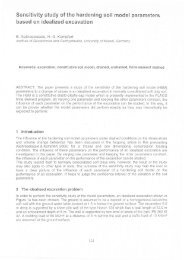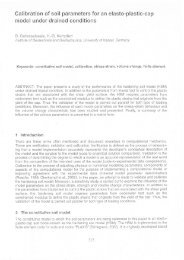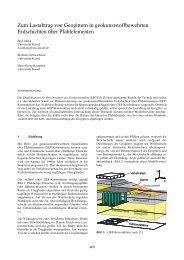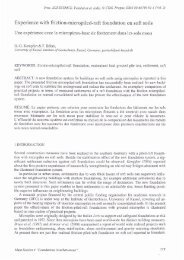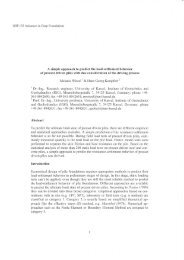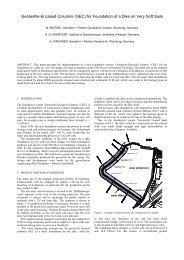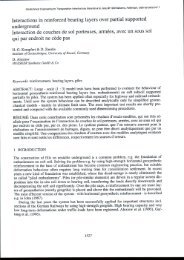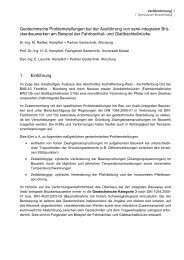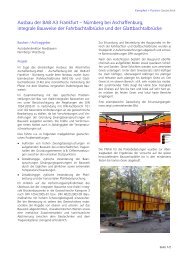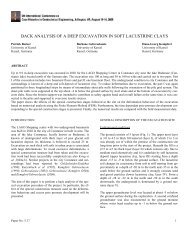Load Bearing Behaviour of Geotextile Containers Using Velcro Strips
Load Bearing Behaviour of Geotextile Containers Using Velcro Strips
Load Bearing Behaviour of Geotextile Containers Using Velcro Strips
Create successful ePaper yourself
Turn your PDF publications into a flip-book with our unique Google optimized e-Paper software.
<strong>Load</strong> <strong>Bearing</strong> <strong>Behaviour</strong> <strong>of</strong> <strong>Geotextile</strong> <strong>Containers</strong> <strong>Using</strong> <strong>Velcro</strong> <strong>Strips</strong><br />
Comportement à l'appui des conteneurs géotextiles avec de bande velcro<br />
J. Lüking & H.-G. Kempfert<br />
Institute <strong>of</strong> Geotechnics, University <strong>of</strong> Kassel, Kassel, Germany<br />
ABSTRACT<br />
<strong>Geotextile</strong> containers are made <strong>of</strong> soil as a filling material and a casing <strong>of</strong> woven or non woven geotextile, which exercises the function<br />
<strong>of</strong> a packaging. The field <strong>of</strong> use is an alternative to the hard construction methods <strong>of</strong> concrete or stones in the coastal construction<br />
and hydraulic engineering. Advantages <strong>of</strong> the geotextile containers are the high cost efficiency and the protection <strong>of</strong> natural resources,<br />
because the filling material is available already on site, without a need for long routes <strong>of</strong> transport. Furthermore, they integrate better<br />
in the landscape and are easy to remove. Due to the extremely smooth surface <strong>of</strong> the geotextile packaging, the containers have only a<br />
low internal stability <strong>of</strong> the structure and the construction height is limited. With the help <strong>of</strong> velcro strips fastened on the surface <strong>of</strong><br />
the geotextile containers, the friction between the layers <strong>of</strong> geotextile containers can be improved substantially. Due to the increase <strong>of</strong><br />
the internal stability <strong>of</strong> the structure there are new applications possible, for example using the geotextile containers as a supporting<br />
structure for slope stability. The efficiencies <strong>of</strong> the velcro strips were examined using a shear box apparatus under different boundary<br />
conditions (arrangement <strong>of</strong> the velcro strips, pollutions <strong>of</strong> the surface, humidity, load steps). The tests show a clear increase <strong>of</strong> load<br />
bearing behaviour. The effectiveness <strong>of</strong> the faster depends mainly on the type <strong>of</strong> velcro strips and on the amount <strong>of</strong> soil particles present<br />
on the surface <strong>of</strong> the velcro strips. In order to estimate the increase in bond analytically, parameters (adhesion factors and wall<br />
friction angles) were derived from tests and the behaviour <strong>of</strong> a geotextile container construction as a supporting structure was investigated<br />
in general by experimental and numerical investigations. The use <strong>of</strong> geotextile containers can therefore lead to an economical<br />
and ecological construction method.<br />
RÉSUMÉ<br />
Les conteneurs géotextiles se componsent d'une matière terreuse comme fond et une enveloppe en textile non-tissé ou en tissu, qui ont<br />
la functon d'un emballage. Leur domaine d'application est une alternative aux méthode de construction dures, actuellement repandues<br />
de béton et des pierres dans la construction de côtes et l'aménagement des voies navigables. Des avantages des conteneurs géotextiles<br />
se trouvent dans la haute rentabilité et le ménagement des ressources naturelles, puisqu' en général le rembourage est déjà disponible<br />
sur place sans longs trajets de transport.En outre ils s'intègrent mieux à l'image de paysage et sont plus faciles à démontés. En raison<br />
de la surface très lisse de l'emballage géotextile, les conteneurs ont seulement un bas accrochage et une basse adhérence de frottement.<br />
Il en résulte que les construction n'ont pas assez de stabilité intérieure. Pour cela, la hauteur de construction est limitée. A l'aide de<br />
bande velcro disposé à la surface, la capacité de charge est augmentée. A l'aide d' essai de cisaillement, une bande velcro convenable<br />
était testée sous les conditions variées (l'ordre des bandes velcro, pollutions de la surface, humidité, des charges différentes) et était<br />
aussi étudiée dans des essais de système ainsi que l'efficacité était prouvé. L'accrochage et adhérence de frottage peuvent distinctement<br />
être augmentée par l'application de bonde velcro entre les conteneurs géotextiles. Des paramètres étaient déduits dans des essais<br />
et de calculs numériques pour prendre cette augmentation en considération par des calculs. Ainsi l'application de conteneurs géotextiles<br />
empilés en sécurité peut servir à une méthode de construction plus économique et écologique.<br />
Keywords: geotextile container, supporting structure, velcro strips, geotechnical engineering, slope stability<br />
1 INTRODUCTION<br />
In the last decades geotextiles have proved themselves in<br />
coastal and geotechnical engineering very well. Started as with<br />
sealing functions at waste dumps or reinforcement at slope stabilisations,<br />
geotextiles were soon used as packaging material for<br />
geotechnical purposes. The forerunner role was, besides, the<br />
synthetic sandbags for the protection <strong>of</strong> dikes at river and<br />
coastal areas in case <strong>of</strong> storm flood and high water. Nowadays<br />
geotextiles containers are produceable in most forms and dimensions.<br />
They are produced <strong>of</strong> non woven geotextile predominantly<br />
(Heibaum 2002). The geotextile containers are an alternative<br />
to the hard construction methods in the coastal<br />
engineering and are furthermore easy to remove. Normally the<br />
filling material is already on site and because <strong>of</strong> this the costs<br />
for transportation to the construction site are reduced and natural<br />
resources are spared. The range <strong>of</strong> application is extremely<br />
varied. In the last years the geotextile containers were used successfully<br />
as scour protection (Saath<strong>of</strong>f & Witte 1994), erosion<br />
protection at beaches and dunes (Heerten et al. 2000), groyne<br />
(Restall et al. 2002) or synthetic reefs and breakwater walls<br />
(Jackson & Hornsey 2003). In addition an application as a supporting<br />
structure for slopes is conceivably. Volumes from small<br />
sandbags to several cubic metres and even up to 1000 m 3 including<br />
geotubes are possible (Pilarczyk 1997).<br />
There is no general calculation formula available for the design<br />
<strong>of</strong> geotextiles containers. The stability <strong>of</strong> a geotextile containers<br />
construction depends on the deformation behaviour <strong>of</strong><br />
each container, the stress distribution and the movement <strong>of</strong> the<br />
sand grains inside the containers, porosity <strong>of</strong> load effects by water,<br />
the filling degree <strong>of</strong> a container and as a main point the friction<br />
between the containers (Recio & Oumeraci 2005).<br />
Because <strong>of</strong> a determining influence <strong>of</strong> friction on the load<br />
bearing behaviour, different model tests and numerical calcula-
tions were carried out to investigate the effect <strong>of</strong> velcro strips<br />
between each container layers.<br />
2 STATE OF THE ART<br />
Because <strong>of</strong> the different field <strong>of</strong> applications it is not possible to<br />
develop a general calculation formula. In fact the design must<br />
occur project-specific.<br />
The filling degree is <strong>of</strong> great importance for an optimum adaptation<br />
<strong>of</strong> the container to the neighbouring elements. After<br />
Oumeraci et al. (2002) the optimal filling degree is about 80 %<br />
to the theoretical filling volume. A lower filling rate abets<br />
movements <strong>of</strong> the container and a rearrangement <strong>of</strong> the sand<br />
grains is possible. A higher filling rate reduces the contact area<br />
to the neighbouring elements. In analogy to masonry constructions<br />
an overlapping <strong>of</strong> each container raises the stability <strong>of</strong> the<br />
whole construction.<br />
In the known projects a sand with the density in a range between<br />
1,4 to 2,0 kg/dm 3 was used as a filling material (Bezuijen<br />
et al. 2004). However, the filling material must be adjusted with<br />
the permeability <strong>of</strong> the geotextiles due to tidal variations. So the<br />
geotextile should be designed as a filter or should have a minimum<br />
permeability from 10 times higher than the filling material<br />
(Restall et al. 2004).<br />
After Heibaum (2002) the mass per unit area should be more<br />
than 500 g/m 2 and the tensile strength more than 25 kN/m. A<br />
high elongation <strong>of</strong> the geotextile is <strong>of</strong> great importance. The<br />
danger <strong>of</strong> damage during installation is reduced and the container<br />
can adapt itself to the other container better. After Restall<br />
et. al. (2004) an ultimate elongation <strong>of</strong> greater than 50 % is recommended.<br />
The UV resistance is in regions with high UV-radiation<br />
(> 180 Kilo Langleys) a main design point for long term survivability<br />
<strong>of</strong> the container. It is tested by a MBTF Lamp and a<br />
minimum <strong>of</strong> 80 % strength retention is recommended after an<br />
672 h illumination, which correspond to a lifetime <strong>of</strong> 10 years<br />
(Restall et al. 2004).<br />
Furthermore there should be a resistance against abrasion<br />
and damage by vandalism. For the determination <strong>of</strong> the abrasion<br />
resistance the German rotating drum test method is recommended<br />
(Restall et al. 2004). After 80.000 rotations <strong>of</strong> the geotextile<br />
in a water/gravel mixture there should be a 75 % strength<br />
retention.<br />
More information about application range and design advices<br />
can be found in Heibaum et al. (2008).<br />
Anything about a systematic investigation <strong>of</strong> using velcro<br />
strips for getting a better connection between the geotextile containers<br />
is not known.<br />
3 SHEAR TESTS<br />
For the investigation <strong>of</strong> the friction between each container layers<br />
shear tests (element tests) were conducted out. The examined<br />
area in the shear test apparatus amount to 100 cm 2 . Different<br />
microplast velcro strips (type 1 and type 2) and different<br />
types <strong>of</strong> geotextiles (a staple fibres s<strong>of</strong>t needle punched non<br />
woven (500 g/m 2 ) and a staple fibres strong needle punched non<br />
woven (600 g/m 2 ) geotextile) under several load levels were examined.<br />
Furthermore the influence <strong>of</strong> pollution and humidity on<br />
the load bearing behaviour was studied. The pollution was<br />
simulated by a sand strewed test specimen with a total mass <strong>of</strong><br />
7,5 g. With it the effectiveness <strong>of</strong> polluted velcro strips (e.g. at<br />
the installation process) should be checked. The velcro stripe<br />
was installed in the middle <strong>of</strong> the test specimen and was sewn<br />
up with the geotextile. Two different microplast velcro stripes<br />
with a width <strong>of</strong> 8 mm were tested.<br />
Figure 1 and figure 2 shows some chosen results.<br />
From the results <strong>of</strong> the tests the parameter in equation 1<br />
could be derived. They are shown in figure 3 and table 1.<br />
τ = a + σ ⋅ tan δ<br />
(1)<br />
where τ is the shear stress, σ is the vertical stress, a is the adhesion<br />
factor and δ is the wall friction angle. In case <strong>of</strong> pollution<br />
the adhesion factor decrease significantly and the wall friction<br />
angle increase slightly.<br />
shear stress τ [kN/m 2 ]<br />
100<br />
80<br />
60<br />
40<br />
20<br />
0<br />
0 5 10 15 20 25<br />
shear displacement [mm]<br />
Figure 1. Chosen results <strong>of</strong> the shear tests<br />
shear stress τ [kN/m 2 ]<br />
100<br />
80<br />
60<br />
40<br />
20<br />
without velcro<br />
strips<br />
without velcro<br />
strips, polluted<br />
with velcro<br />
strips, type 1<br />
with velcro<br />
strips, type 1,<br />
polluted<br />
with velcro<br />
strips,<br />
type 2<br />
with velcro<br />
strips, type 2,<br />
polluted<br />
without velcro<br />
strips<br />
with velcro<br />
strips, type 1<br />
with velcro<br />
strips, type 2<br />
0<br />
0 1 2 3 4 5<br />
number <strong>of</strong> shearing<br />
Figure 2. Decreasing <strong>of</strong> shear stress against increasing number <strong>of</strong> shearings<br />
shear stress τ [kN/m 2 ]<br />
160<br />
120<br />
80<br />
40<br />
0 40 80 120 160<br />
normal stress σ [kN/m2 0<br />
]<br />
Figure 3. Deriving <strong>of</strong> an adhesion factor (best-fit line)<br />
without velcro<br />
strips<br />
with velcro<br />
strips, type 1<br />
with velcro<br />
strips, type 1,<br />
polluted<br />
with velcro<br />
strips, type 2<br />
with velcro<br />
strips, type 2,<br />
polluted<br />
The results <strong>of</strong> the shear tests can be summarised as followed.<br />
An increase in the load bearing behaviour can be achieved by<br />
the use <strong>of</strong> velcro stripes. The increase depends mainly on the<br />
type <strong>of</strong> the velcro strips. With type 2 is a clear increase visible.<br />
In comparison with that shows type 1 only a low increase. In a<br />
case <strong>of</strong> pollution the effectiveness <strong>of</strong> the velcro strips decrease
clearly, see figure 1. The humidity reduces the bearing behaviour<br />
about approx. 10 to 20 %.<br />
Table 1. Summary <strong>of</strong> the derived adhesion factors and wall friction<br />
angles for the different shear tests<br />
Adhesion<br />
factor a<br />
[kN/m 2 Wall friction<br />
angle<br />
] δ [°]<br />
Without velcro strips 4,9 21,6<br />
With velcro strips, type 1 5,9 24,7<br />
With velcro strips, type 1, polluted 1,2 28,8<br />
With velcro strips, type 2 93,8 23<br />
With velcro strips, type 2, polluted 4,1 28,2<br />
A repeated shearing means a high reduction in effectiveness.<br />
After the third shearing the load bearing behaviour is comparable<br />
to the model tests without velcro strips, see figure 2.<br />
To the full mobilisation <strong>of</strong> the maximum shear stress a<br />
movement <strong>of</strong> approx. 1.5 cm is necessary.<br />
A stable fibre strong needle punched non woven geotextile is<br />
better suitable than a s<strong>of</strong>t needle punched one, because the fibres<br />
do not pull out so easy.<br />
It is important to the fact, that the container should not have<br />
contact with each other until the end state <strong>of</strong> positioning during<br />
the installation process on the construction site. If the containers<br />
are parted from each other repeatedly, that would mean a clearly<br />
reducing <strong>of</strong> the effectiveness <strong>of</strong> the velcro strips, because they<br />
clogged with stripped fibres.<br />
4 SIMULATION OF A SUPPORTING STRUCTURE<br />
This model test is conducted out for checking the increase in<br />
bearing behaviour as shown in the element tests.<br />
A supporting structure was reconstructed as shown in figure<br />
4 and 5 in a scale <strong>of</strong> 1:3. Two model tests were carried out.<br />
<strong>Containers</strong> with and without velcro strips were used. The dimensions<br />
<strong>of</strong> the container were 0,55 m x 0,4 m x 0,1 m (length<br />
x width x height). They were filled with 26 kg sand (filling degree<br />
80 %). The velcro strips were arranged in a distance <strong>of</strong><br />
15 cm. The inclination <strong>of</strong> the construction against the horizontal<br />
was 80°. The load was increasing in different load steps until<br />
the construction collapsed. The movement <strong>of</strong> each container<br />
were determined by a tachometric deformation measurement.<br />
supporting structure<br />
<strong>of</strong> geotextile<br />
containers<br />
load plate<br />
(A = 1,12 m 2 )<br />
1,10 m 0,80 m<br />
load<br />
Figure 4. Schematic view <strong>of</strong> the model test<br />
0,55 m<br />
sand<br />
1,70 m<br />
0,90 m<br />
0,20 m<br />
The results <strong>of</strong> the deformation measurement are shown in<br />
figure 7 and 8 in comparison to the numerical calculations.<br />
At a loading rate <strong>of</strong> 66,7 kN/m 2 the structure without velcro<br />
strips sheared <strong>of</strong>f between the first, second and the third layer<br />
(seen from below). Furthermore a high relative deformation between<br />
each container layers was noticeable. The construction<br />
collapsed in each splices.<br />
The second model test with using the velcro strips shows a<br />
different result. At a loading rate <strong>of</strong> 107 kN/m 2 a slope failure<br />
takes place. Moreover a lateral buckling were found out. No<br />
damage at the supporting structure was visible. It reacted like a<br />
monolithic block. Only a low relative deformation between each<br />
containers was detectable.<br />
Figure 5. Front view <strong>of</strong> the supporting structure<br />
The velcro strips have proved their effectiveness. The failure<br />
appeared in the soil body and different deformation behaviour<br />
<strong>of</strong> the structure was visible. Unfortunately only velcro strip type<br />
1 was available at the time <strong>of</strong> this model test.<br />
5 NUMERICAL CALCULATION<br />
The purpose <strong>of</strong> the numerical calculations was the back calculation<br />
<strong>of</strong> the experimental tests and the suitability <strong>of</strong> the program<br />
for this issue. The numerical calculations were conducted out<br />
with the finite-elemente program system PLAXIS 8.2. A two<br />
dimensional numerical model was generated as shown in figure<br />
6.<br />
Figure 6. Generated model for the numerical calculations<br />
The filling material and the geotextiles <strong>of</strong> the containers<br />
were simulated by a linear-elastic material model. The sand was<br />
emulated by Mohr-Coulomb.<br />
The modelling <strong>of</strong> the splice between the containers is a decisive<br />
factor for realistic results. However there had to be done<br />
some simplifications, because the simulation <strong>of</strong> the behaviour <strong>of</strong><br />
the containers between each other by the FE-program is problematic.<br />
For simulating the contact between the container layers<br />
a 2 mm high continuum element was arranged.<br />
Figure 7 and 8 show the results <strong>of</strong> the numerical calculation<br />
in comparison to the experimental tests.<br />
The calculated deformations were smaller then the measured<br />
one. So by applying the factor 4 to the FE-results the deforma-
tion using FEM can provide a qualified representation <strong>of</strong> the<br />
model test results. The reasons for this divergence are seen in<br />
the simplification <strong>of</strong> the numerical model, particular in the<br />
modelling <strong>of</strong> the geotextile containers.<br />
height <strong>of</strong> the construction z [m]<br />
1<br />
0.8<br />
0.6<br />
0.4<br />
0.2<br />
0<br />
slipping between the<br />
first and second<br />
container layer<br />
0 1 2 3 4 5 6<br />
relative displacement u [cm]<br />
Figure 7. Results <strong>of</strong> the experimental tests and the numerical calculations<br />
(without velcro strips)<br />
height <strong>of</strong> the construction z [m]<br />
1<br />
0.8<br />
0.6<br />
0.4<br />
0.2<br />
0<br />
0 1 2 3 4 5 6<br />
relative displacement u [cm]<br />
Figure 8. Results <strong>of</strong> the experimental tests and the numerical calculations<br />
(with velcro strips)<br />
6 CONCLUSIONS<br />
8,9 kN/m2 surcharge<br />
35,6 kN/m 2<br />
44,5 kN/m 2<br />
57,8 kN/m 2<br />
66,7 kN/m 2<br />
numerical<br />
results ⋅ 4<br />
experimental<br />
results<br />
8,9 kN/m2 surcharge<br />
35,6 kN/m 2<br />
44,5 kN/m 2<br />
57,8 kN/m 2<br />
66,7 kN/m 2<br />
numerical<br />
results ⋅ 4<br />
experimental<br />
results<br />
This paper examined the increase in bearing behaviour <strong>of</strong> geotextile<br />
containers using velcro strips. A clear increase <strong>of</strong> load<br />
bearing behaviour could be observed. The shear tests show that<br />
this increase depends mainly on the type <strong>of</strong> the used velcro<br />
strips. Because <strong>of</strong> this it is recommended to carry out some<br />
shearing tests before using the velcro strips. Furthermore an adhesion<br />
factor could be derived.<br />
Pollution reduces the effectiveness <strong>of</strong> the velcro strips significantly.<br />
During installation it is important to mind a not polluted<br />
surface <strong>of</strong> the geotextiles. Moreover the humidity reduces<br />
the bearing behaviour in a low way. After a repeated shearing no<br />
increase in bearing behaviour was determinable.<br />
The effectiveness <strong>of</strong> the velcro strips could be demonstrated<br />
in a replica <strong>of</strong> a supporting structure in a scale 1:3. With no use<br />
<strong>of</strong> velcro strips the containers sheered <strong>of</strong> between the first and<br />
the second layer. With the use <strong>of</strong> the velcro strips the containers<br />
acted like an monolithic and a slope failure could be observed.<br />
It is possible to calculate a container construction by FEprograms,<br />
which are used in practice. Nevertheless, the applica-<br />
tion should occur with caution, because the numerical results<br />
had to verified by a factor. This must be examined by further<br />
studies.<br />
ACKNOWLEDGMENT<br />
This paper is based on research projects sponsored by the<br />
German Federal Ministry <strong>of</strong> Education and Research (BMBF).<br />
The authors thanks for the financial support.<br />
REFERENCES<br />
Bezuijen, A., de Groot, M.B., Klein Breteler, M. & Berendsen,<br />
E. 2004. Placing accuracy and stability <strong>of</strong> geocontainers.<br />
Proceedings <strong>of</strong> the Third European Geosynthetics Conference.<br />
Munich, Germany, vol. 1: 123-128<br />
Heerten, G., Saath<strong>of</strong>f, F. & Stelljes, K. 2000. <strong>Geotextile</strong> Bauweisen<br />
ermöglichen neue Strategien im Küstenschutz. Geotechnik<br />
23, no. 2: 80-86<br />
Heibaum, M. 2002. Geokunstst<strong>of</strong>f-Container – ein neues und<br />
nahezu unbegrenztes Anwendungsgebiet. Geotechnik 25,<br />
no. 4: 254-260.<br />
Heibaum, M., Oberhagemann, K., Faisal, M.A. & Haque, S.<br />
2008. <strong>Geotextile</strong> bags for sole permanent bank protection.<br />
Proceedings <strong>of</strong> the Fourth European Geosynthetics Conference.<br />
Edinburgh, United Kingdom<br />
Jackson, L.A. & Hornsey, W.P. 2002. An artificial reef to protect<br />
surfers paradise beach – developing and implementing<br />
the science. Geotechnical Fabrics Report 20, no. 4: 18-25<br />
Oumeraci, H., Bleck, M., Hinz, M. & Kübler, S. 2002.<br />
Großmaßstäbliche Untersuchungen zur hydraulischen Stabilität<br />
geotextiler Container unter Wellenbelastung. Research<br />
report <strong>of</strong> the Department <strong>of</strong> Leichtweiß-Institute,<br />
University <strong>of</strong> Braunschweig. Germany: unpublished<br />
Pilarczyk, K.W. 1997. Application and design aspects <strong>of</strong> geocontainers.<br />
Proceedings <strong>of</strong> the “Geosynthetics ‘97” North<br />
American Conference, Long Beach, California, USA: 147-<br />
160<br />
Recio, J. & Oumeraci, H. 2005. Analyse der stabilitätsgefährdenden<br />
Prozesse von Deckwerken aus geotextilen Sandcontainern<br />
(GSC). Tagungsband 5. FZK Kolloquium Seegang,<br />
Küstenschutz und Offshorebauwerke. Hanover, Germany:<br />
83-87<br />
Restall, S.J., Hornsey, W.P., Oumeraci, H., Hinz, M., Saath<strong>of</strong>f,<br />
F. & Werth, K. 2004. Australien & German experiences<br />
with geotextile containers for coastal protection. Proceedings<br />
<strong>of</strong> the Third European Geosynthetics Conference. Munich,<br />
Germany, vol. 1: 141-146<br />
Restall, S.J., Jackson, L.A., Heerten, G. & Hornsey, W.P. 2002.<br />
Case studies showing the growth and development <strong>of</strong> geotextile<br />
sand containers: an Australien perspective. <strong>Geotextile</strong>s<br />
and Geomembranes 20: 321-342<br />
Saath<strong>of</strong>f, F. & Witte, J. 1994. <strong>Geotextile</strong> Sandcontainer zur<br />
Stabilisierung der Kolkböschungen, HANSA – Schifffahrt –<br />
Schiffbau – Hafen 131. no. 4: 69-71<br />
Quelle:<br />
Lüking, J. / Kempfert, H.-G. (2009): <strong>Load</strong> <strong>Bearing</strong> <strong>Behaviour</strong><br />
<strong>of</strong> <strong>Geotextile</strong> <strong>Containers</strong> <strong>Using</strong> <strong>Velcro</strong> <strong>Strips</strong>;<br />
Proceedings <strong>of</strong> the 17 th International Conference on Soil<br />
Mechanics and Geotechnical Engineering: The Academia<br />
and Practice <strong>of</strong> Geotechnical Engineering; Alexandria<br />
(Egypt), 5–9 October 2009, Vol. 1, pp. 897-900



